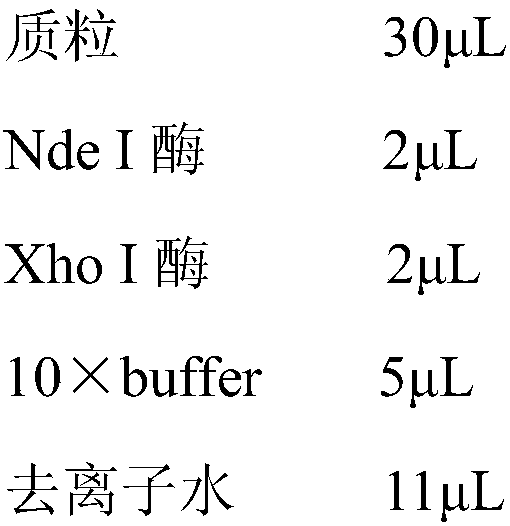Fumonisin degrading enzyme, coding gene, recombinant vector, cell, additive and application thereof
A fumonisin and recombinant cell technology, applied in the field of biotechnology, can solve the problems of long degradation time, unavailability, low removal efficiency, etc., and achieves the effects of good stability, low pH value and environmental friendliness.
- Summary
- Abstract
- Description
- Claims
- Application Information
AI Technical Summary
Problems solved by technology
Method used
Image
Examples
Embodiment 1
[0069] This example is used to illustrate the degrading enzyme provided by the present invention and its preparation method and application.
[0070] (1) Acquisition of genes
[0071] The following nucleotide fragments were synthesized by artificial chemical synthesis (commissioned Bao Bioengineering (Dalian) Co., Ltd., the same below); at the 5' end of the nucleotide sequence shown in SEQ ID NO: 1, the initiation codon ATG was added Add the Xho I restriction site before the Nde I restriction site and the 3' end codon TAG.
[0072] (2) Construction of recombinant plasmids
[0073] Use restriction endonucleases Nde I and Xho I (purchased from NEB Company) to perform double enzyme digestion on the PET30a plasmid (with His tag, purchased from Invitrogen Company, USA), and digest it in a water bath at 37°C for 4 h, and the enzyme digestion system (50 μL) as follows:
[0074]
[0075] After agarose gel electrophoresis, the digested product was purified and recovered. Then, a...
Embodiment 2
[0086] This example is used to illustrate the degrading enzyme provided by the present invention and its preparation method and application.
[0087] The degrading enzyme was prepared according to the method of Example 1, and the influence of temperature and pH on the enzyme activity was determined, except that SEQ ID NO: 3 was used instead of SEQ ID NO: 1.
Embodiment 3
[0089] This example is used to illustrate the degrading enzyme provided by the present invention and its preparation method and application.
[0090] The degrading enzyme was prepared according to the method of Example 1, and the influence of temperature and pH on the enzyme activity was determined, except that SEQ ID NO: 4 was used instead of SEQ ID NO: 1.
PUM
 Login to View More
Login to View More Abstract
Description
Claims
Application Information
 Login to View More
Login to View More - R&D Engineer
- R&D Manager
- IP Professional
- Industry Leading Data Capabilities
- Powerful AI technology
- Patent DNA Extraction
Browse by: Latest US Patents, China's latest patents, Technical Efficacy Thesaurus, Application Domain, Technology Topic, Popular Technical Reports.
© 2024 PatSnap. All rights reserved.Legal|Privacy policy|Modern Slavery Act Transparency Statement|Sitemap|About US| Contact US: help@patsnap.com










